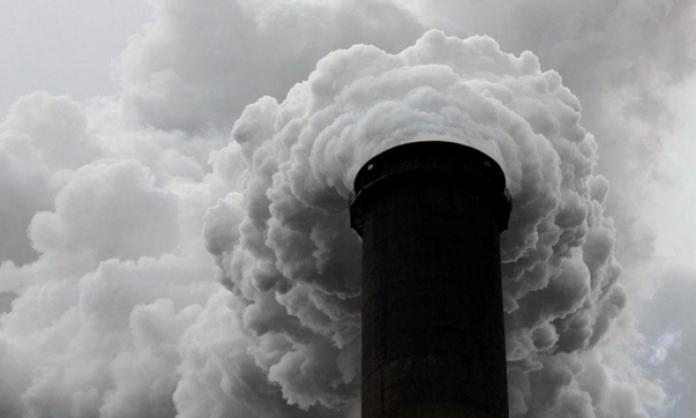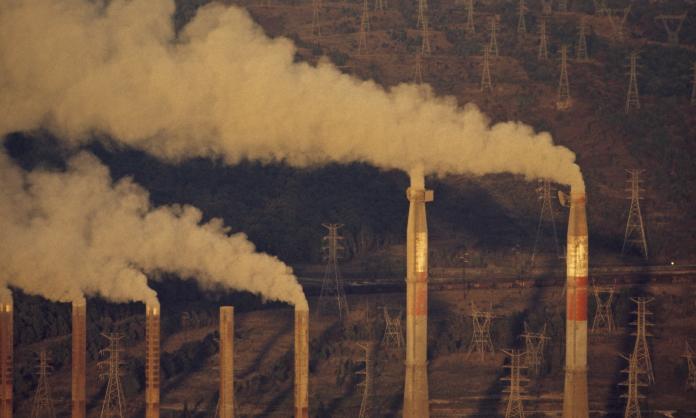Prime minister Scott Morrison, an evangelical who is adamant that coal comes before Christ, is under the delusion that the combustible rock is “a heaven born gift to man”, as John Leifchild, author of Our Coal and Coal Pits, wrote. Without coal, the heavens themselves would fall in.
Morrison’s coal worship is just one case of fossil fuel fetishism. Fetishism obscures the social role of an object like coal. Coal fetishism believes coal “maintained the state or spread miracles” through its own powers. Coal has awakened perils enough to destroy much life on this planet. But coal itself never did anyone harm. When left in the ground, it performs valuable ecological work absorbing toxins, carbon and substances dissolved in ground water – from uranium to cadmium and mercury. It is poisonous when recovered from the depths of the Earth and burned.
British colonists in India were gobsmacked that local tribes in the Khasi Hills, in the country’s north-east, had no interest in exploiting deposits on a large scale. Locals knew that coal lay in the subterranean depths, but only with the British Empire’s extraction in the service of the steamboats plying up and down the Ganges did coal become an item of colonial power as the fossil economy was born. The steamboat was one of the most important inventions in the history of imperialism; it carried the European powers into Asia and Africa. As such, coal was foundational to the 19th century colonial dream of global domination.
Daniel Headrick, a historian of technologies, wrote in his book Tools of Empire that “no single piece of equipment is so closely associated with the idea of imperialism as is the armed shallow draft steamer, in other words, the gunboat”. The British won the Opium Wars in China on the back of the gunboat. Steamboat imperialism was also deployed in the frenzied “scramble for Africa”. Winston Churchill’s description of the 1899 conquest of Sudan, The River War, written during his time as an army officer, put the gunboat front and centre of the British victory:
“But at the critical moment the gunboat arrived on the scene and began suddenly to blaze and flame from Maxim guns, quick firing guns and rifles. The range was short; the effect tremendous. The terrible machine floating gracefully on the waters – a beautiful white devil – wreathed itself in smoke. The river slopes of the Kerreri Hills, crowded with the advancing thousands, sprang up into clouds of dust and splinters of rock. The charging Dervishes [the fiercest military force in Africa at the time] sank down in tangled heaps. The masses in the rear paused, irresolute. It was too hot even for them.”
International conquest wasn’t the only thing driving the energy revolution. Class power and factory discipline – the manufacturers’ need to keep control of those who made their profits – were at the root of the rise of steam power. As Andreas Malm argues forcefully in Fossil Capital, the class basis of fossil fuels is essential to their history:
“No piece of coal or drop of oil has yet turned itself into fuel, and no humans have yet engaged in systematic large-scale extraction of either to satisfy subsistence needs: fossil fuels necessitate waged or forced labour – the power of some to direct the labour of others – as conditions of their very existence. If we take the message of climate science seriously, we should direct our attention to power in the dual sense [energy and social domination], first of all in the process of labour. That is the point of contact between humans and the rest of nature, where biophysical resources pass into circuits of social metabolism, where coal and oil and gas are extracted, transported, coupled to machines: burnt. The process is peopled ... [the labour process] is the sphere where the fossil economy must have originated.”
Historians too often miss this important point, taking the social conditions of capitalist society to be eternal natural laws. For example, economists influenced by David Ricardo, a 19th century British political economist, say that coal was adopted because there wasn’t enough fertile land for continuing economic growth. Others, influenced by English cleric and scholar Thomas Malthus, say that coal’s adoption resolved a so-called crisis of overpopulation. Such explanations are complemented by technologically deterministic arguments that assume that the supposed intrinsic superiority of the rotation engine – as opposed to wind and water-based mechanics – automatically ensured steam power a cheap and bright future.
Yet the transition took place despite other energy sources remaining abundant and cheaper. The shift to steam in the British cotton industry, for example, occurred despite water power being consistently cheaper. The technologies competing with the steam engine, Malm notes, “retained considerable potential for technological prowess unrealised at the time of the transition, and steam power even lacked the edge in instrumental terms of performance”. The largest cotton mills were water powered during the transition years of the 1820s to the 1840s. Waterwheels were on par with steam engines in absolute capacity and energy efficiency. As Malm argues, “steam gained supremacy in spite of water being abundant, cheaper and at least as powerful, even and efficient”.
An alternative explanation for the transition to steam is that it arose as a form of power exercised by some people against others. British capitalists killed any possibility of a hydraulic renaissance in the 1830s as manufacturers switched from the water wheel, which used the natural flow of river water to generate power, to the steam engine because of competition among them and the struggle between bosses and workers in the factories.
Take the Irwell Scheme, a plan to power the cotton mills using water power. Mills for cotton, wool, paper, timber, iron, bleaching and printing lined the River Irwell from Bacup, Lancashire, to Manchester. If every business were to use water power, there needed to be cooperation between rival mill owners up and down the river. But competition among manufacturers pushed in the opposite direction. Steam power gave each capitalist independence from the other.
Capitalist private property did not mix with the flowing waters of the commons; the ability to cart coal from the marketplace into the mill to fuel the competition made steam power more congenial to capitalism’s competitive logic. Instead of a renaissance of water power, British capital moved sharply toward steam. This was not because steam power was a more advanced technology. As Malm writes, the opposite was true: “the engine won over the wheel because it was the less advanced productive force”.
The watermill, inherited from Asia and the Roman Empire, gave us industrial capitalism. But the steam engine, Karl Marx wrote, was “an antagonist that enabled the capitalists to tread underfoot the growing demands of the workers, which threatened to drive the infant factory system into crisis”. The transition to steam power, within the framework of capitalist domination, was facilitated by its mobility and reliability, two key ingredients of profit making and class domination. Cotton mills reliant on waterways were situated outside of the cities and were geographically fixed – they had to procure, train and discipline their exploited workforce and build costly riverside colonies. But the extraction of coal and its conversion into mechanical motion via the steam engine were separated – unlike water power, which required the river and the wheel to be in the same place.
“Instead of carrying the work to the power, the prime agent is placed wherever it is most convenient to the manufacturers”, wrote mechanical engineer John Farey in his 1827 work A Treatise on the Steam Engine. And instead of relying on the personalised relations between masters and servants in the riverside mills, cotton manufacturers drew on the hungry and undernourished labourers in the cities, hiring and firing at ease to discipline them. Where river water ebbed and flowed with the upstream rainfall, coal provided reliability: it could be stored and used on demand. The steam engine was a more efficient means of extracting surplus wealth from the working class, rather than being a more efficient technology
In response to the Lancashire handloom weavers’ rebellion in 1826, the government went to great lengths to protect the source of capitalist power. The 1827 Administration of Justice statute relating to malicious injuries to property made punishable by death any collective attempt to damage manufacturers’ buildings and steam engines. The act also made it a transportable offence of seven years for causing water damage to a mine (i.e. made a convict of someone found guilty). But it was greater punishment for seriously damaging a mine: “If any Person shall unlawfully and maliciously set fire to any Mine of Coal or Canal Coal, every such Offender shall be guilty of Felony, and, being convicted thereof, shall suffer Death”. This also went for anyone who tried to “pull down or destroy ... any Steam Engine”.
Draconian as these penalties were, they didn’t stop workers resisting. Steam was written about as despotic, degrading and filled with doom. Working class writers penned their hatred of steam power and linked it to their own class struggles. For example, mechanics relayed to the London and Westminster Review that “steam is our enemy; it is the servant of the rich man, and does nothing to serve us, but, on the contrary, throws us out of work by giving its labour at a cheaper rate”.
Sabotage is often written about as a sporadic and unconscious act, but Malm shows that sabotage of steam engines during the general strike of 1842 – which combined demands for democratic reforms with demands to end pay cuts – “was not incidental but constitutive of the general strike”. He quotes a striker’s speech to thousands of assembled workers: “And now I ax ye, will ye pull the plugs out?” “Aye, we’l do’t for ’em”, the crowd roared back. The Leeds Times called this “the plug doctrine”. When strikers marched through the manufacturing districts, they pulled out plugs affixed to the steam engine boilers, bringing them to an abrupt halt.
The 1842 movement showed that strike action could bring the fossil economy to a standstill, defy authority and set up parallel forms of power. When the military was brought in to quell the uprising, the strike was defeated. But this was the most cooperative, collective and extensive arrest of steam power at the heart of the empire. The Chartists wrote about steam power being the organising centre of class power. Their newspaper, the Northern Star, argued: “Already do we find our army, our navy, our pulpits, our offices, and our senate house filled with scions of the steam aristocracy”.
There are two take home points about this history. First, capitalism gave us the fossil fuel economy now threatening humanity’s place on the planet, and it has always harmed the labouring classes most severely. Second, class struggle demonstrates that workers have the power to confront the fossil fuel economy. The 1842 strike, Malm writes, “was an uprising for decent living standards and political power – ‘a fair day’s wage for a fair day’s work’, plus the Charter – in which the fossil economy figured as the material terrain of the struggle, one party rolling forth its ragged brigades to seize and close it, the other its uniformed soldier, to retake and open it”.
In the 19th century, the forcible retaking and opening of the coal pits and the use of the steam engine were about enforcing class domination in the name of profit, but also were about securing Britain’s colonial domination. Today, class domination and imperialism are bringing our way of life into question; capitalism has developed into a manufacturer of economic and geopolitical rivalry on an unprecedented scale. The fossil fuel economy is wreaking havoc on the natural environment and those of us inhabiting it, through both exploitation and conquest driven by polluting militarism. Brown University’s Costs of War, for example, has revealed that the US Department of Defence is “the world’s largest institutional user of petroleum and correspondingly, the single largest producer of greenhouse gases in the world”, after the major polluting economies.
The lessons of the past are crucial for informing the campaigns of the present. The road to zero emissions will not be an easy path of lobbying, awareness raising and changed consumer behaviour. It will require a major class confrontation by workers to take over and run the economy in our interests and a fight against imperialism and the military-industrial complex.










